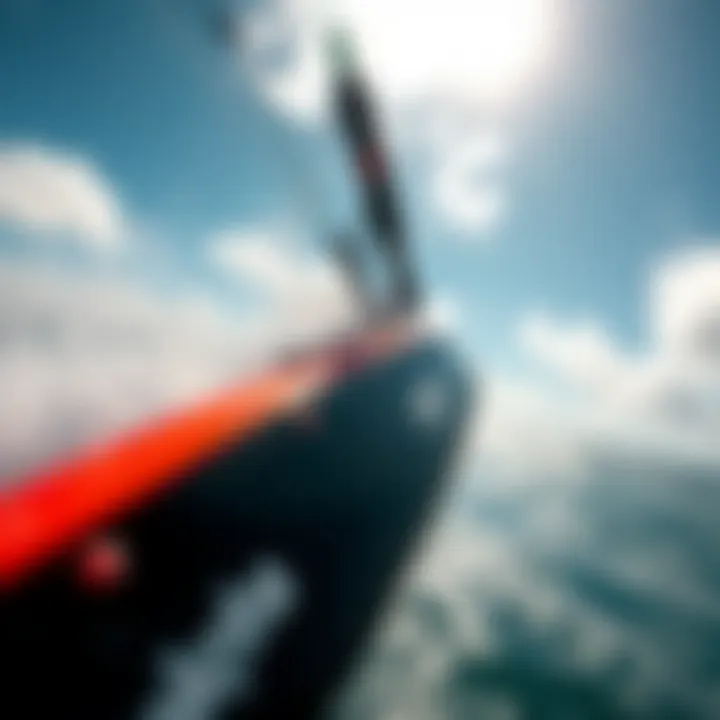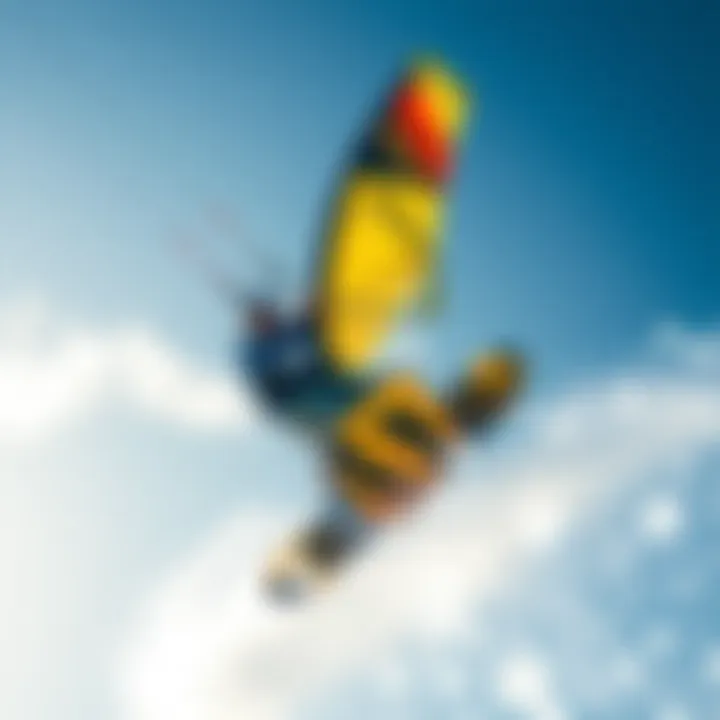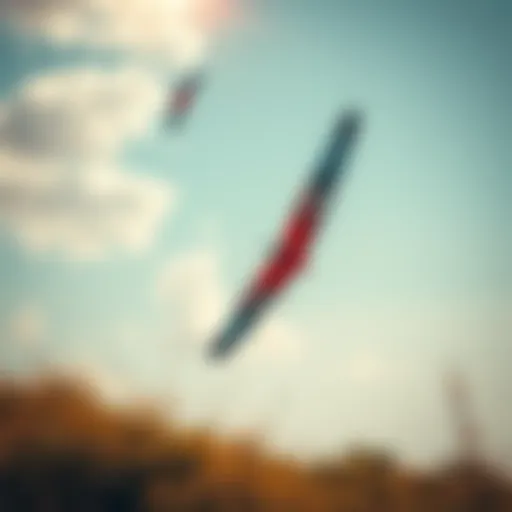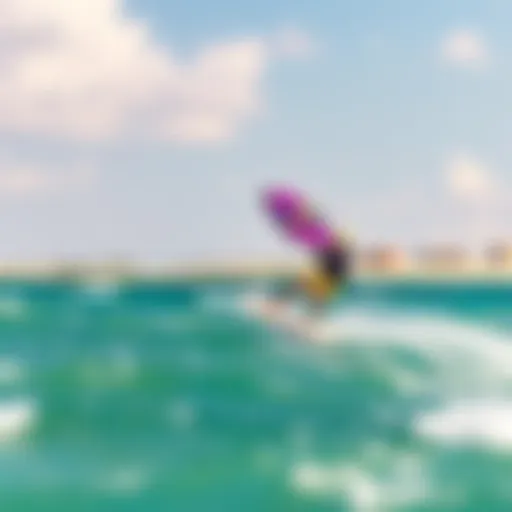Exploring the Wind Range of the Cabrinha Switchblade Kite


Intro
When it comes to kiteboarding, understanding the wind range of the gear you’re using can make or break your experience. The Cabrinha Switchblade is a kite that has established a solid reputation for its versatility and performance across a variety of wind conditions. For both newbies and seasoned riders, delving into how this kite performs under different atmospheric pressures can enhance your time on the water. Getting a grip on the nuances surrounding the Switchblade’s wind range opens up a new realm of possibilities for kiteboarding adventures.
In this article, we’ll traverse the features of the Cabrinha Switchblade in relation to its wind range. We will discuss the kite's design elements, how they perform in light winds compared to stronger gusts, and practical ways to utilize this information to improve your riding experience. Along the way, we'll also touch on gear essentials and safety tips that are crucial for kiteboarders keen on mastering their sport.
By the end of this guide, readers will be equipped with all the necessary insights to make informed decisions not just regarding the Cabrinha Switchblade but kiteboarding gear as a whole.
Gear and Equipment
Essential Kiteboarding Gear for Beginners
For those stepping into the kiteboarding world, having the right equipment can feel like diving into a sea of choices. But worry not—the basic kit doesn’t have to be overwhelming. When choosing your first setup, consider the following essentials:
- Kite: The Cabrinha Switchblade is an excellent starting point. Its reliable handling and wide wind range allow for flexible riding.
- Control Bar: Pick a control bar that fits comfortably in your grip. The Cabrinha Quickloop Control Bar is an ideal match, simplifying your adjustments.
- Harness: Look for a harness that provides both comfort and support. Many beginners favor seat harnesses for added security, while others may prefer the mobility offered by waist harnesses.
- Board: Opt for a board that matches the kite size you choose. A larger board will offer more stability in lighter winds, while a smaller board can enhance performance when the wind picks up.
Advanced Equipment for Experienced Riders
As kiteboarders gain experience, their equipment needs evolve. Advanced riders often seek equipment that pushes the boundaries of performance. Here’s a glimpse into what that entails:
- Custom Kite Sizes: Experienced riders might prefer to own several kites of varying sizes. This allows them to adapt quickly to changing wind conditions. A 12m Switchblade may be ideal for moderate winds, while a 9m can handle stronger breezes better.
- High-Performance Board: Boards designed for speed and agility, such as the Cabrinha Mission, might appeal to seasoned riders craving adrenaline.
- Advanced Control Systems: Upgraded control systems that offer more precise adjustments can significantly enhance handling, particularly in turbulent winds.
Techniques and Tips
Safety Practices for Kiteboarding
Safety should always be top of mind when engaging in any extreme sport. Here are some practices to keep in mind:
- Know the Wind: Always check wind forecasts before heading out. Websites such as windfinder.com provide reliable information.
- Flag Your Gear: If you're out alone, ensure that your kite is flagging well on the beach. It’s essential for notifying other users of your activities.
- Self-Rescue Skills: In case of an emergency, knowing how to perform a self-rescue can be a lifesaver. Practice this technique during calm wind conditions so it becomes second nature.
- Wear Protective Gear: Invest in a good helmet and impact vest, particularly when you’re starting out or trying new tricks.
Training Techniques to Improve Your Skills
Improving your skills in kiteboarding is an ongoing journey. Here are some effective training techniques:
- Take Lessons: Nothing beats professional guidance. Look for certified instructors in your area who can tailor lessons to your skill level.
- Practice Water Starts: Getting up on the board quickly focuses on using the kite's power efficiently. Practice makes perfect here.
- Work on Transitions: Smooth transitions between toeside and heelside riding not only improve your skill set, but also your overall control of the kite.
"Understanding your gear and its capabilities is as vital as knowing the wind itself." - A seasoned kiteboarder.
By grasping the intricacies of the Cabrinha Switchblade and practicing these techniques, you’ll be well-prepared to tackle everything from light gusts to bracing winds.
Preface to Cabrinha Switchblade
When discussing kiteboarding, one name frequently surfaces: Cabrinha. Their Switchblade model is not merely a kite; it stands as a hallmark of performance and design innovation. In this section, we'll explore why the Cabrinha Switchblade holds such significance in the kiteboarding community.
Understanding the Switchblade involves delving into its roots and what has made it a reliable choice for both novices and seasoned riders alike. The design integrates years of expertise, resulting in a kite that not only performs well across a broad range of wind conditions but also provides stability and control—it’s designed to deliver the ultimate kiteboarding experience.
The craftsmanship behind the Switchblade is a blend of cutting-edge materials and ingenious design philosophies, which contribute to its wind range capabilities. With a focus on enhancing user experience, the Switchblade caters to those looking for agility in light winds while also standing its ground during more extreme breezes.
Key Elements of the Cabrinha Switchblade
- Versatility: Able to handle a spectrum of wind conditions, it powers riders through various scenarios.
- User-friendly: The kite’s design supports easy handling, making it appealing for beginner kiteboarders.
- Performance efficiency: Its aerodynamic shape and robust construction enhance lift and stability, optimizing each rider’s performance.
Benefits of Understanding this Kite
- Informed Decisions: By familiarizing oneself with the Switchblade, riders can make knowledgeable equipment choices.
- Enhanced Safety: Knowing the wind range helps mitigate risks, ensuring that riders are well-prepared for changing weather.
- Skill Development: A thorough understanding of the Switchblade can aid users in improving their kiteboarding skills, adapting smoothly to different winds.
Ultimately, a profound understanding of the Cabrinha Switchblade not only elevates one’s riding experience but also ensures that safety and skill growth remain top priorities.
Technical Specifications of the Switchblade
Understanding the technical specifications of the Cabrinha Switchblade is vital for kiteboarders who want to optimize their performance across varying wind conditions. Knowing the details of the Switchblade's construction and design informs users about its capabilities and limitations, leading to more informed decisions on when and how to ride. These specifications do not only contribute to ride quality but also impact safety and overall enjoyment. With this regard, let’s dissect this further.
Construction and Materials
The Cabrinha Switchblade's durability and performance stem from its advanced construction techniques and high-quality materials. The kite typically utilizes a combination of ripstop polyester and other synthetic fibers, providing a balance between light weight and ruggedness. This fusion results in a robust structure that withstands the wear and tear from environmental exposure. Notably, such materials make it resistant to punctures and tears – essential for kiteboarding where sharp objects like rocks can be lurking under the water’s surface.


Particularly, the Switchblade features Double Layer Dacron on the leading edge and struts. This layer enhances the kite's stiffness, offering improved support, especially in gusty conditions. It’s like giving the kite a backbone, ensuring that it maintains its intended shape when tension is applied.
Furthermore, the attention given to the stitching—often referred to as the kite’s ‘lifeline’—is another critical aspect. High-tensile threads are commonly used, providing reliable performance over an extended period. The kite undergoes rigorous testing, and only those that meet strict quality control standards make it to the consumer.
Overall, the Switchblade’s construction ensures that users get a kite capable of handling a variety of conditions while providing security and stability.
Wing Shape and Profile
The wing shape and profile of the Cabrinha Switchblade is engineered to enhance its versatility in wind range performance. The kite's moderate aspect ratio contributes to its balanced performance, making it suitable for both beginners and advanced riders. A lower aspect ratio generally aids in better stability and control, factors that are crucial for learners while still offering the thrill experienced riders look for.
The broad wingspan allows for extended lift while creating substantial drag, which assists in an excellent downwind capability. Such design characteristics mean that the Switchblade works well in different wind conditions, allowing users to ride confidently regardless of environmental challenges.
Additionally, the kite’s profile is designed for increased efficiency. When the wind hits the kite, it flows smoothly over the wing surface, promoting a steady lift without excessive drag. This aspect is particularly noticeable during transitions and jumps, where maintaining momentum is key.
Thus, understanding the wing shape and profile not only complements the construction aspects but also highlights the kite’s adaptability in varied riding scenarios. It’s a blend of artistry and engineering that brings out the best in kiteboarding, making the Switchblade a commendable choice for those who seek reliable wind range performance.
A kite's performance is only as good as the materials and design that hold it together.
When selecting gears, knowing the technical specifics allows kiteboarders to harness the full potential of the Cabrinha Switchblade, making each ride a fulfilling experience.
Understanding Wind Range
Understanding the wind range is crucial when engaging in kiteboarding, especially when it comes to the Cabrinha Switchblade. This section delves into various aspects of wind range, focusing on its role, benefits, and considerations that are essential for both novice and experienced kiteboarders. Knowing how to navigate wind conditions can dramatically impact a rider's performance and enjoyment on the water. The Switchblade, known for its versatility, thrives within a specified wind range, offering riders optimal performance under varying conditions.
Defining Wind Range in Kiteboarding
When we talk about wind range in kiteboarding, we're essentially discussing the spectrum of wind speeds within which a kite can operate effectively. Each kite, specifically the Cabrinha Switchblade, has been designed with a certain wind range in mind. This means that there are minimum and maximum wind speeds at which the kite performs well, ensuring both safety and mechanical efficiency.
For instance, if the wind is too light, like a gentle breeze barely moving the water, the Switchblade may not have enough power to lift the rider off the surface. Conversely, if the winds pick up too much, say during a squall or a sudden gust, the kite may become overly responsive, leading to challenges in control. Understanding these thresholds is key to enjoying a session without unnecessary risks.
Importance of Wind Range
The importance of recognizing the wind range cannot be overstated. Here are a few crucial points to consider:
- Performance Optimization: The Switchblade excels when riders work within its ideal wind range. This ensures that the kite delivers maximum lift and stability, which translates to efficient gliding and maneuverability.
- Safety: Choosing to ride outside the recommended wind conditions can lead to precarious situations. For example, riding in winds that are too light can result in gusty lulls where control is lost, while strong winds can cause the rider to be overpowered. Knowing when to stay on shore is as important as knowing when to ride.
- Confidence Building: Having a clear understanding of wind conditions can help build a rider’s confidence. It empowers them to make informed decisions regarding when and where to kite, ensuring enjoyable experiences every time.
"A well-informed rider is a safe rider—knowing your kite’s wind range is the first step to mastery."
Ultimately, a solid grasp of wind range helps improve not only individual performance but also the overall kiteboarding community, fostering a culture of education, safety, and respect for the sport. By recognizing the nuances of the Cabrinha Switchblade's wind range, riders can truly harness its capabilities, ensuring they'll ride with ease, even when nature throws its curveballs.
Cabrinha Switchblade Wind Range Analysis
When it comes to kiteboarding, the wind acts as both friend and foe. Understanding the Cabrinha Switchblade wind range is not just about grasping numbers; it’s about comprehending how these figures translate to real-world riding experiences. This analysis isn’t merely a technical breakdown; it’s the foundation of enhanced performance and safety on the water.
The Cabrinha Switchblade is designed with versatility in mind. By examining its wind range, riders can optimize their sessions, pushing the boundaries of their skills while ensuring they ride within safe parameters. This knowledge helps riders pick their moments wisely. Imagine planning a day out and knowing exactly when to hit the waves based on the wind forecast. It transforms kiteboarding from a guessing game into a strategic adventure.
Optimal Wind Conditions for Performance
A kite’s wind range is heavily influenced by its design, and the Switchblade excels in versatility. Optimal conditions vary, but generally speaking, the kite thrives in steady winds between 14 and 20 knots. During this range, the Switchblade delivers maximum lift and stability. If the wind starts whistling below 10 knots, the kite might struggle to stay aloft, resulting in frustration for the rider.
However, the savvy kiteboarder knows that adaptability is key. Riding the Switchblade in breezy conditions, say 18 to 25 knots, can lead to spectacular aerial tricks, thanks to its responsive design. But remember that in winds over 25 knots, while the Switchblade maintains control, it demands an experienced hand.
"The ability to gauge what the kite can do amidst wind fluctuations is vital. One day could feel like a thrill ride, while another may seem like a battle against nature itself."
Threshold Wind Speeds
Knowing the threshold wind speeds is crucial for any kiteboarder. Updrafts and sudden shifts can be as wild as a roller coaster ride. The Switchblade ideally operates at wind speeds starting from around 10 knots. If you're gearing up, understand that below this threshold, the kite may sit there, motionless like a duck on a pond.
For performance enthusiasts, 20 knots is often the sweet spot, providing enough push for advanced maneuvers but not enough to put a rookie in over their head. In high winds, say 30 knots and above, the Switchblade remains remarkably stable but it’s essential to be aware of the risks that come with such gusts.
Here’s a quick rundown of the thresholds:
- 10-12 knots: Might be too light – consider this for beginners.
- 12-20 knots: Optimal for those looking to enjoy versatility and speed.
- 20-30 knots: High-performance territory, good for tricks but risky for less experienced riders.
Impact of Wind Variability


Wind variability can affect your ride significantly. One moment you’re breezing along, and the next—not so much. The Cabrinha Switchblade adapts well, but it’s still up to the rider to read the wind. Sudden changes in wind speed can cause turbulence, leading to instability. A sudden lull might send you crashing, while a gust can push you higher than intended. A keen understanding of local conditions gives riders an edge.
When navigating variability, consider:
- Local Weather Patterns: Familiarity with your riding spot’s quirks can prevent unwarranted surprises.
- Kite Control: How the Switchblade reacts to unexpected wind shifts is crucial—having the ability to manage the kite’s power can mean the difference between a thrilling aerial maneuver or a swift descent into the water.
- Equipment Suitability: Ensure that your gear matches your ability to handle varying conditions. A kite that suits one breeze may not perform the same with another.
Conclusively, dissecting the wind range of the Cabrinha Switchblade is not just academic; it’s central to mastering kiteboarding and achieving exhilarating, safe rides. Arm yourself with knowledge and feel the wind in your favor.
Performance Metrics in Different Wind Conditions
When it comes to understanding the Cabrinha Switchblade, discussing performance metrics in varying wind conditions becomes essential. Each wind category influences how the kite behaves, and knowing these dynamics can mark the difference between an exhilarating session or a frustrating day on the water. This section breaks down the kite's capabilities in low, medium, and high winds, ultimately guiding all kiteboarding enthusiasts in making more informed choices.
Low Wind Performance
Kiteboarding in light winds can make or break a session. For the Cabrinha Switchblade, achieving a solid low wind performance is a strong suit. The kite typically launches easily and maintains lift at lower speeds, thanks to its large surface area and efficient design. Riders will often find that the Switchblade glides smoothly in winds ranging from around 10 to 15 knots. This makes it an excellent choice for those days when the air is as still as a mill pond.
When kiteboarding in these conditions, it's crucial to consider certain elements relating to gear. Using a larger board with more volume can assist in going against the wind. Also, opting for a light wind-specific bar setup enhances control and response, ensuring that the kite retains its power.
Key benefits of low wind performance include:
- Greater accessibility for beginners
- Ability to enjoy longer rides in calm conditions
- Reduction in frustratingly slow sessions
Medium Wind Dynamics
Medium winds, often considered the sweet spot for most kiteboarders, cover a range from about 15 to 25 knots. Here, the Cabrinha Switchblade truly showcases its versatility. With this kite, riders experience solid pull and responsive handling. The balance between power and stability creates a natural feel, allowing for smooth transitions and jumps, without the unpredictability often found in higher wind conditions.
It's also during these conditions that advanced techniques like freestyle tricks can be practiced more effectively. Riders often report that they can achieve a better pop and controlled landings, making that seemingly impossible trick feel doable. This performance can be attributed to the kite's wing shape and the construction design, which contributes to better aerodynamics.
In medium winds, it's advisable for riders to pay attention to their line lengths. Shorter lines allow for quicker turns and more immediate feedback from the kite, enhancing quick maneuvers.
High Wind Characteristics
High winds—those gusty conditions beyond 25 knots—pose a different set of challenges and dynamics. While many kites may falter, the Cabrinha Switchblade excels by maintaining its performance in such strong gales. Its design provides a solid framework that allows for better control even in choppy waves and heavy gusts. Interestingly, many experienced riders feel that the Switchblade has a responsive character that adds a different thrill during these extreme conditions.
Riding in high winds requires finesse. The rider must focus on steering techniques to manage the kite's power without overpowering it. Keeping a steady line tension is essential, and some riders tend to favor using smaller boards for improved maneuverability.
High wind considerations include:
- Prioritizing a proper harness for comfort
- Adjusting kite size appropriately based on wind forecast
- Focusing on a lower center of gravity during jumps for smoother landings
In essence, the performance metrics of the Cabrinha Switchblade in varying wind conditions are significant for riders of all levels. Understanding how the kite behaves can lead to safer and more enjoyable experiences on the water, enabling kiteboarders to push their limits while having a blast.
"An informed rider makes for a happy rider, especially when winds shift unexpectedly."
For more information about kiteboarding gear and techniques, check out helpful resources like Wikipedia or community discussions on Reddit. If you want to learn more about wind dynamics, consult resources from government sites or educational institutions.
User Experiences and Testimonials
User experiences and testimonials play a crucial role in understanding the real-world performance of the Cabrinha Switchblade. Unlike an online ad or product description, rider feedback provides insight rooted in personal experience. Those who have spent time on the water with this kite offer invaluable perspectives that can guide both new and seasoned kiteboarders in making informed choices.
The voices of intermediate and advanced riders reveal the strengths and weaknesses of the Switchblade in diverse wind conditions. From discussions about handling quirks to adaptability in gusty weather, each testimonial adds depth to the kite's profile. When hearing from others who are out there, engaging with the elements, one gains a better appreciation of what this kite can do and what to expect.
Feedback from Intermediate Riders
Intermediate riders often have a unique viewpoint, balancing excitement and caution as they explore their abilities. Many frequently mention how the Cabrinha Switchblade feels under different wind speeds. A common sentiment is that the kite's stability in gusty winds boosts their confidence. Riders point out that it gives them a solid platform to practice various tricks without worrying too much about unmanageable power.
A few intermediate users highlight the following points in their reviews:
- Ease of Control: Many express how the Switchblade offers responsive steering. They can nip those powerful gusts without feeling overpowered, a concern for less experienced riders.
- User-Friendly Design: Comments often touch on the accessibility of the kites’ features. From adjustable settings to its dependable performance, the Switchblade invites users to develop their skills while providing room to grow.
- Wind Range Praise: Many also appreciate how well the kite performs in both low and medium wind scenarios. This flexibility allows them to go out more often, thus increasing their time on the water.
Advanced Riders' Perspectives
When it comes to advanced riders, their perspectives reveal an intricate relationship with the Cabrinha Switchblade. Typically, they seek rigorous performance and precision, aiming to push limits. Feedback from this group might delve deeper into technical aspects, often analyzing aspects like responsiveness, jumping capabilities, and overall agility.
Common threads found in the conversations among advanced riders include:


- Performance in High Wind: Many riders feel confident pushing the Switchblade to its limits. They praise how the kite maintains stability without compromising control even in challenging conditions.
- Handling and Speed: A recurring appreciation comes for the kite's ability to generate speed quickly. Riders note that once they engage it in high wind, its quick movements allow for seamless transitions, especially when performing aerial tricks.
- Durability and Reliability: Experienced users also touch on the durability of the kite. For those who go out often, this trait is essential, especially when dealing with the inevitable rough patches.
"The Cabrinha Switchblade doesn't just fly; it connects to the rider. The balance it offers in unpredictable winds makes every session an adventure, not a gamble."
— Advanced Rider
Gear Pairing Recommendations
Selecting the right gear to complement the Cabrinha Switchblade is a cornerstone of optimizing your kiteboarding experience. When it comes to harnessing the capabilities of the Switchblade, pairing it with suitable hardware is not merely a preference but a necessity. The right board and harness can heighten performance, offer better control, and enhance comfort while ensuring safety on the water. These elements work hand in hand, creating a symbiotic connection between rider and equipment.
Choosing the Right Board
When you’re gearing up with the Switchblade, a board optimized for its performance characteristics is essential. The most common types of boards are directional and twin-tip boards, each with unique benefits that suit different riding styles.
- Directional Boards: Great for surf-style kiteboarding, these boards provide stability and grip in waves. If you find yourself riding in big surf or choppy conditions, a directional board might be your best bet. Pairing it with the Switchblade can offer a smooth and responsive feeling, giving you confidence in your maneuvers.
- Twin-tip Boards: If your focus is on freestyle tricks or flatwater riding, a twin-tip board could be the way to go. These boards allow for easy riding in either direction. This flexibility becomes particularly useful when utilizing the Switchblade in varying wind conditions, as they adapt quickly to directional changes while maintaining speed.
Key Considerations:
- Board Size: Choose a board based on your weight and the wind conditions you typically encounter. A larger board can help in lower wind speeds, while a smaller board may be better in strong winds.
- Rockers and Flex: Look for boards with appropriate rocker profiles and flex ratings that match the Switchblade’s dynamics. A stiffer board can handle higher speeds well, while a more flexible board provides a soft landing for tricks.
Harness Compatibility
The significance of a compatible harness cannot be overstated when using the Switchblade. It serves as the connection point between the kite and the rider, providing comfort and control essential for effective riding. Choosing the right harness can significantly impact your overall experience, especially as different styles cater to varied riding techniques.
- Seat Harnesses: These harnesses sit lower on the body and are often easier to manage. They’re a good fit for riders looking for stability and support, especially when engaging in more aggressive maneuvers. Seat harnesses can offer a sense of security that a rider might find comfort in while navigating stronger winds with the Switchblade.
- Waist Harnesses: A popular choice among many riders, waist harnesses offer more freedom of movement. They fit snugly around the waist and allow for a larger range of motion, which can be advantageous for jumpers and freestyle riders. If you enjoy making radical aerial maneuvers with the Switchblade, a waist harness can facilitate that flexibility.
Tips for Harness Selection:
- Fit and Comfort: Ensure that the harness fits well and feels comfortable. It should fit snugly without being restrictive, allowing for movement while keeping you secure.
- Support Features: Look for harnesses with adequate lumbar support, particularly if you’re planning on long sessions on the water. Features like padding and adjustable straps can enhance the experience considerably.
Choosing compatible gear for the Cabrinha Switchblade doesn't simply enhance performance; it fosters a stronger bond between rider and equipment. Assessing your riding style, preferences, and the type of conditions you typically encounter will guide you to make informed decisions. Happy riding, and may the winds be ever in your favor!
"The right gear can be half the battle in kiteboarding. Match your equipment to your style and the conditions, and you're setting yourself up for success."
Safety Considerations
In the world of kiteboarding, where adrenaline meets the open air, safety cannot be brushed aside. The Cabrinha Switchblade's wind range capabilities directly connect to how riders manage their environment. It’s essential for both novice and experienced kiteboarders to grasp these safety intricacies. Understanding how wind conditions influence safety helps ensure an enjoyable ride that minimizes risk.
A kite's performance can significantly alter depending on wind strength and consistency. Variability in wind conditions can result in unexpected reactions from the kite, thus making it crucial for riders to be prepared. In essence, knowing your kite and the conditions you’re flying in can be the difference between a thrilling adventure and a hazardous situation. Here’s a closer look at how wind affects safety and why making safety a priority is a must.
Understanding Wind Effects on Safety
Wind can be capricious, embodying both the thrill and the peril of kiteboarding. The influence of wind on safety can be boiled down to several core aspects:
- Power Dynamics: As wind speed increases, so does the power of the kite. It’s vital to understand how much strength your kiting setup can handle before it becomes unmanageable. A kite like the Switchblade, designed for a wider range, can translate lower winds into more user-friendly experiences, but it still requires respect and caution.
- Wind Direction: Crosswinds, headwinds, and tailwinds can significantly impact your control. Knowing how to read and adapt to these winds is crucial. A sudden change in direction or gust can cause loss of control, so being vigilant is key.
- Gusty Conditions: Wind gusts can catch even seasoned riders off guard. Sudden spikes in strength might result in jerky movements, possibly leading to accidents. Testing the waters before fully committing is advisable.
Understanding these factors can aid a rider in not just avoiding injury, but also enhancing their enjoyment of the sport. When in doubt, take a step back, assess the conditions, and weigh the risks. Remember, safety should always sit at the forefront.
Emergency Procedures in Varied Wind Conditions
Preparation for unexpected situations is the hallmark of a safe kiteboarder. Knowing how to react in varied wind conditions enables a rider to stay in control, even when the water gets rough. Here are crucial procedures to follow:
- Keep a Clear Escape Path: Always be aware of where you can go if conditions take a turn for the worse. Look for areas free of obstructions or other beachgoers.
- Know Your Release Mechanisms: Familiarize yourself with your kite’s safety systems. Being able to quickly release the kite can prevent serious injuries if control is lost. Take time before hitting the waves to practice this in calm conditions.
- Communicate with Others: Whenever you're out on the water, let someone know your plans and the conditions you’re facing. In case things go sideways, having someone aware of your situation can make all the difference.
- Monitor Your Energy Levels: In challenging conditions, gauge your fatigue. If tired, consider calling it a day. Fatigue can lead to poor decision-making and increased risk.
- Seek Help: Don’t hesitate to seek assistance if things start to escalate. Other riders or instructors may have valuable advice or support to offer.
"The best kiteboarders are not those who have never fallen but those who have learned to get back up with both knowledge and caution."
By incorporating these emergency procedures into your routine, you can navigate unexpected wind changes with confidence. Kiteboarding should always be about enjoyment, so equipping yourself with safety knowledge ensures a more positive experience on the water.
In the end, the Cabrinha Switchblade is a superb kite, but knowing how to handle it safely in diverse wind conditions is what makes the real difference between a memorable session and an accident. Always respect the elements, and you’ll be sure to ride another day.
Finale and Recommendations
Summary of Key Insights
When it comes to the Cabrinha Switchblade, several key insights create a clearer picture of its wind range capabilities:
- Versatility Across Conditions: The Switchblade shines whether you're cruising in lighter breezes or tackling stronger winds. Its design has been fine-tuned to cater to riders in various wind scenarios.
- Performance Metrics: Riders reported that the kite maintains stability and responsiveness even as conditions shift unexpectedly, making it a reliable choice for both novices and seasoned kiteboarders.
- Gear Pairings: The kite works impressively with a range of boards, but finding the right match can influence your overall experience and performance significantly.
- Safety First: An understanding of the kite's wind range is critical not only for performance but for ensuring riders can navigate emergency scenarios effectively.
While these insights are informative, they serve a practical purpose. Adapting one’s riding to include the nuances of the Switchblade’s wind range can elevate your kiteboarding adventures.
Final Thoughts on the Cabrinha Switchblade
Make an effort to test your equipment under diverse wind scenarios. Through practice and feedback, you will gain invaluable insights into how the kite responds and what conditions suit your riding style best. Above all, always respect the power of the wind. A kiter who understands their gear and environment is a safer kiter. As the saying goes, “knowledge is power,” and this rings especially true in the world of kiteboarding.
For those eager to dive deeper into specifics about safety measures, recommended pairings, or technical specs, check out additional resources on Kiteboarding Safety or Cabrinha's Official Website. Such insights aren't just textbooks to flip through; they are your guides for better experiences amid the waves.



